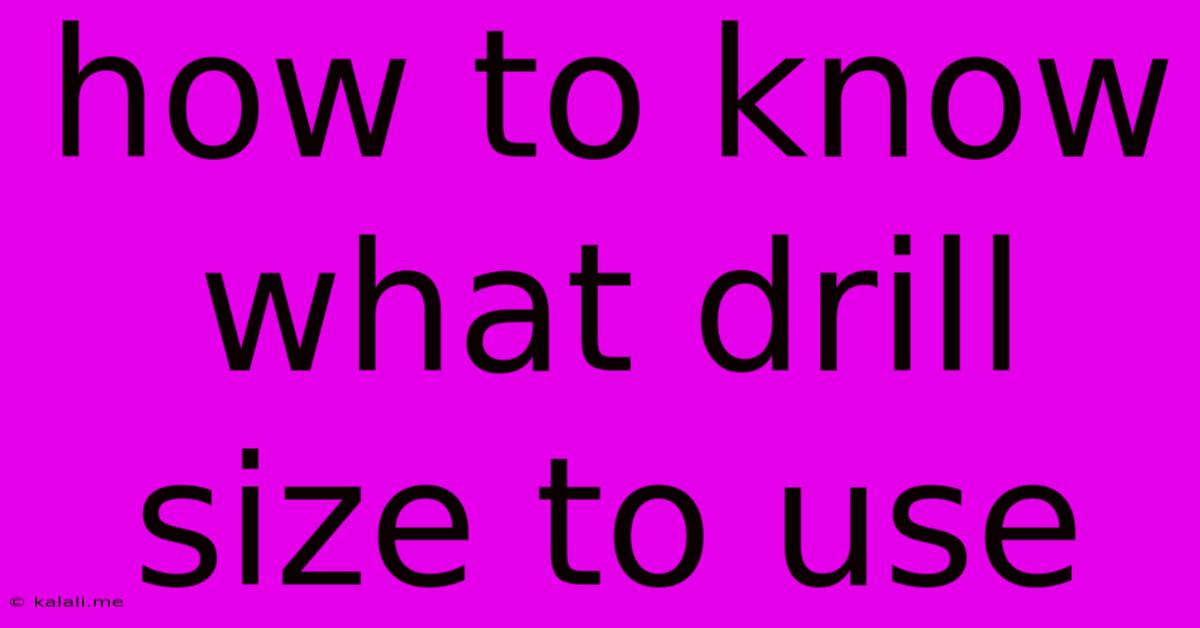How To Know What Drill Size To Use
Kalali
Jun 05, 2025 · 3 min read

Table of Contents
How to Know What Drill Bit Size to Use: A Comprehensive Guide
Choosing the right drill bit size can seem daunting, but with the right knowledge, it becomes straightforward. This guide will help you confidently select the correct drill bit for your project, avoiding frustrating mistakes and ensuring a clean, accurate result. Whether you're a seasoned DIYer or a complete beginner, understanding these principles is crucial for any drilling task.
Understanding Drill Bit Sizes and Measurement Systems
Drill bits are measured in fractions of an inch (e.g., 1/16", 1/4", 3/8") or millimeters (mm). Knowing which system your bits use is the first step. Most commonly, you'll encounter both, especially when working with hardware from different manufacturers or countries. Always double-check the markings on your drill bit to avoid confusion.
Choosing the Right Drill Bit Size for Screws and Bolts
This is the most common drilling task, and luckily, it's quite simple. You need a drill bit slightly smaller than the diameter of the screw or bolt shank (the unthreaded portion). This creates a pilot hole, guiding the screw and preventing wood from splitting or metal from warping.
- Wood Screws: Use a drill bit size approximately 1/32" to 1/16" smaller than the screw's shank diameter. The pilot hole should only penetrate the wood, not go completely through.
- Metal Screws: The pilot hole in metal should usually be slightly smaller, aiming for a snug fit to ensure the screw bites into the material properly and helps prevent stripping.
- Bolts: For bolts, you'll need a pilot hole that's slightly smaller than the bolt diameter, allowing the bolt to thread into the material easily. This is particularly important in harder materials like steel.
Drilling Through Different Materials
Different materials require different approaches:
- Wood: Softer woods require smaller pilot holes than harder woods. Over-drilling can lead to unsightly holes. Consider pre-drilling larger holes for thicker screws to avoid splitting the wood.
- Metal: Metal requires precision. You may want to use a center punch to mark the exact drilling location and prevent slippage. Use cutting oil or lubricant to reduce friction and heat during drilling.
- Plastic: Plastic is generally easy to drill, but avoid excessive pressure to prevent melting or cracking. Select a sharp drill bit to ensure a clean hole.
- Masonry (brick, concrete): Masonry requires specialized drill bits designed for the material's hardness. Use a hammer drill to aid the process.
Using a Drill Bit Chart
Drill bit charts are readily available online and in hardware stores. These charts provide a quick reference for matching screw sizes to appropriate drill bit diameters. They often include the measurement systems used (inches and millimeters). Keep a chart handy as a helpful guide, especially when starting out.
Tips for Success
- Sharp Drill Bits: Use sharp drill bits for cleaner, more accurate holes. Dull bits require more force, leading to inaccurate holes and potential damage.
- Clamp Your Work: Secure your workpiece firmly to prevent movement during drilling, ensuring accuracy.
- Start Slowly: Begin drilling at a slow speed, gradually increasing the speed once the bit is engaged.
- Apply Even Pressure: Apply consistent, even pressure to avoid damaging the material or the drill bit.
By following these guidelines and consulting drill bit charts, you’ll greatly increase your success rate and confidence when drilling. Remember, practice makes perfect. Experiment with different materials and techniques to hone your drilling skills and achieve professional-looking results.
Latest Posts
Latest Posts
-
Fallout New Vegas Joining The Ncr
Jun 06, 2025
-
By The Word Of Our Testimony
Jun 06, 2025
-
What Do Fennel Seeds Taste Like
Jun 06, 2025
-
How To Fix A Spring On A Couch
Jun 06, 2025
-
How To Know What My Property Water Line Is
Jun 06, 2025
Related Post
Thank you for visiting our website which covers about How To Know What Drill Size To Use . We hope the information provided has been useful to you. Feel free to contact us if you have any questions or need further assistance. See you next time and don't miss to bookmark.